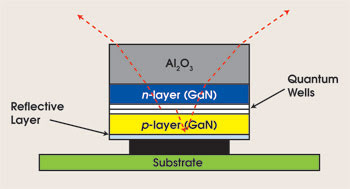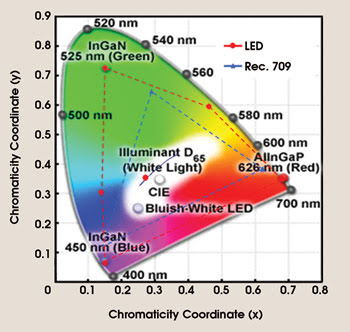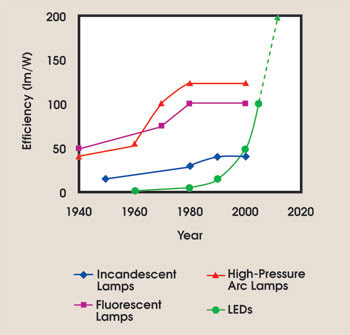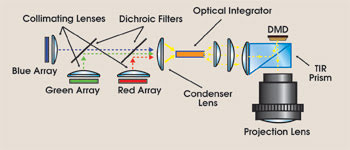Innovations in materials and packaging have increased brightness to the point where LEDs are now used in television displays.
D.J. Segler, Texas Instruments
Recent improvements in light output have enabled new applications for LEDs such as automotive lighting, traffic signals and, more recently, television displays. Improvements in manufacturing the epitaxial material and packaging have enhanced thermal conductivity and increased the overall light extraction efficiency of LEDs (Figure 1). Quantum efficiency gains and unique photon-extraction techniques also have helped improve brightness.

Figure 1. A basic example of the high-brightness LED structure shows a thermally conductive substrate as the basis for this type of LED.
Significant improvements in producing AlInGaP and InGaN structures have enhanced brightness, specifically in green and blue LEDs. Colors such as amber and cyan also are being developed, and all will lead to better color fidelity at a brightness nearly equivalent to that of common lamp-based technologies but with longer lifetimes. Additional performance enhancements include system-level features such as being mercury-free, turning on instantly, not producing sequential color artifacts, having adjustable brightness and exhibiting improved color gamuts (Figure 2).

Figure 2. The gamut area for LED illumination is compared with the common HDTV reference standard (Rec. 709).
LED illumination provides a much larger color gamut — as much as 70 percent more than the high-definition television (HDTV) color standard — providing deeply saturated colors and more accurate color fidelity. These improved attributes can be quite appealing for television applications where long life and excellent color fidelity are required. As LEDs continue to advance in brightness and efficiency, their effect on television applications could be significant (Figure 3).

Figure 3. The evolution of high-brightness LEDs shows their efficiency exceeding that of traditional lighting sources in the coming years.
Technology challenges
Controlling the thermal stability of the LED die is critical to the performance, stability and reliability of the LED illumination. The heat dissipated from the LED must be dealt with to obtain maximum light output and reliability. Additionally, for applications that require imaging of light energy to small imaging devices, such as HDTVs using Texas Instrument’s Digital Light Processing (DLP) technology, any light emitted outside of the system etendue is unusable and only adds to the heat and overall power loading. Controlling this absorption, shaping the light to match the system etendue and maximizing the thermal efficiency to extract heat from the die are all critical to increasing the light output and usability of LEDs.
For traditional applications, LEDs are commonly driven in continuous-wave 100 percent duty cycle mode. For high-brightness applications, however, this is not as desirable. Because the average temperature of the p-n junction determines both the light output and the lifetime of an LED, a smaller duty cycle is more efficient. The devices potentially can be driven to higher current loads to increase the overall light output while maintaining a lower average temperature of the p-n junction; however, the driver circuitry must generate fast-switching waveforms, switching large currents in as little time as a few microseconds. This presents challenges in the design of the LED power driver, although solutions that easily meet these requirements have been developed.
Another challenge that results from higher thermal loading is that of color shift. As the p-n junction changes temperature, the light’s output wavelength can shift by as much as 10 nm or more. This not only affects the color point but also varies the overall white point for the system (because each of the colors ultimately is mixed to create white).
To stabilize this color shift, LEDs must be run at very low power or must maintain extreme thermal stability. However, by implementing some type of system feedback and proper power control algorithms, the stability of each color can be preserved while maintaining high brightness efficiency.
Texas Instruments has developed a DLP HDTV design that uses LED illumination. Products based on the design are in their second generation with several models available by Samsung of Seoul, South Korea. An example of an LED light engine is shown in Figure 4.

Figure 4. In the basic optical configuration of a DLP HDTV LED light engine, the light is collected from each of the diodes through the use of collimating lenses. Dichroic filters are used to combine each of the colors into a single stream of light, which is coupled into an optical integrator with a condenser lens. The optical integrator “randomizes” the light to create a uniform beam at its output (similar to a kaleidoscope). The output of the optical integrator is imaged onto the digital micromirror device using appropriate lenses and a prism. The light is reflected off the mirrors of the digital micromirror device and passed to the projection lens, which sends the light out to a screen, magnifying it by as much as 100×.
The technology is based on a digital micromirror device that contains a rectangular array of up to 2 million hinge-mounted microscopic mirrors, each of which measures less than one-fifth the width of a human hair. When combined with a digital image signal, light source and projection lens, a digital micromirror device and its mirrors can reflect the image onto a screen or other surface.
The new designs use a unique feedback algorithm that adjusts for any color shift variations of the LEDs that could affect the primary or secondary colors, or white. By controlling the overall drive current for each LED and adjusting the duty cycle of each color independently, the design can match precisely and hold the desired color points over a wide range of operating temperatures. The current designs use a high-speed proprietary digital signal processor combined with a low-cost light sensor to process system information in real time. This offers high stability over a wide range of operating temperatures, while maximizing brightness and reliability.
Fast switching
By taking advantage of the high-speed switching capabilities that the digital micromirror devices and LEDs have together, it is possible to generate images with very fast color refresh rates and large dynamic range. Not only can individual colors be sent to the screen rapidly, but multiple colors can be used simultaneously, also. Light pulses that approach 1 μs are now possible with these technologies working together.
Ultimately, images can be created with higher bit depth, better motion fidelity and higher brightness. By increasing the switching frequency of the LEDs, it is possible to drive them at higher currents for maximum light output while minimizing the thermal loading of the p-n junction. Colors can be optimized and mixed quickly, which maximizes the image quality for a video signal. With the multicolor processing algorithms that already exist in several other DLP-based HDTV products, combined with the ability to overlap light pulses from the LEDs, exact and stable color gamuts can be created. The fast switching capabilities of DLP technology and LEDs provide more flexibility for multiple color configurations using a single digital micromirror device.
With a DLP system, the LEDs do not require polarization. The light reflects precisely off the micromirror surface, which efficiently uses the light only when needed. This maximizes brightness and system efficiency while reducing heat and power consumption.
The DLP HDTV designs also incorporate dynamic dimming. Since the drive current of the LEDs is continuously optimized, it is possible to scale the drive current depending on the brightness of the video content. This provides very high contrast ratios, enabling blacks to be completely black. Higher contrast improves the perceived sharpness of the image and offers a more cinemalike viewing experience.
As LED technology continues to improve in brightness and reliability, LED illumination may become more of a mainstream light source. The DLP HDTV designs can take further advantage of the fast LED switching time to improve video performance, to enhance contrast and to create adjustable color gamuts. HDTV displays soon will benefit from these fundamental capabilities and feature unique designs that offer instant-on, better colors and overall better picture.
Meet the author
D.J. Segler is DLP systems engineer with Texas Instruments in Plano, Texas; e-mail: [email protected].